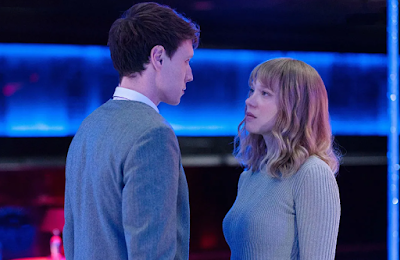As artificial intelligence reigns, emotions have become a threat; to get rid of it, Gabrielle must purify her DNA by diving back into her past lives; she finds a great love there as well as a bad feeling.
Bertrand Bonello’s The Beast is a complex and highly stylized sci-fi melodrama-romantic-horror film that delves into themes of existential dread, love, and fear. Inspired by Henry James’s 1903 novella The Beast in the Jungle, the film explores the lives defined by the fear of an ever-looming catastrophe.
The Beast follows Gabrielle (Léa Seydoux) as she engages in a process of biological purification in 2044 Paris, allowing her to revisit past lives. The narrative oscillates between three timelines: Paris in 1910, Los Angeles in the present, and Paris in 2044. In each era, Gabrielle and Louis (George MacKay) are lovers who can never fully reconnect, their interactions pervaded by a sense of doom and existential dread.
The 1910 episode is a highly stylized period piece shot in 35mm, capturing the essence of a historical drama. Here, Gabrielle is a frustrated pianist and a creature of the salon, living in a time of technological threats and natural disasters, including the famous floods that temporarily turned Paris into a Venice-like city. The present timeline, portrayed in a nearly square format, introduces Gabrielle as an exploited actress in Los Angeles, where modern forms of male wickedness, such as incel culture, come into play. The futuristic Paris of 2044 is depicted with a protracted tempo, creating an atmosphere of tension and anxiety.
At its core, The Beast is an exploration of existential dread and the human condition. The film is as much about the awful things that don’t happen as it is about the catastrophic events that do. It delves into the universal anxiety that defines our existence, using Gabrielle’s journey through past lives as a metaphor for the fear of love and the terrors of possibility.
Bonello’s narrative is structured with deliberate bewilderment, creating a challenging and perplexing cinematic experience. The film blends sci-fi intrigue, lavish period drama, and heart-pounding thriller elements, resulting in a disjointed narrative that often feels like three separate films crammed into one. This nonlinear storytelling may initially confuse audiences, but it serves to underscore the themes of time, desire, and self-destruction.
Gabrielle and Louis’s relationship is central to the film, portraying a love that transcends time yet is perpetually doomed. Their yearnings for connection manifest differently across the timelines, reflecting the evolving nature of desire and the impact of technological advancements on human relationships. The film tackles modern issues such as incel culture and narcissism, suggesting that these are byproducts of the digital age’s pervasive loneliness and confusion.
Symbolism abounds throughout The Beast, with references to Madame Butterfly, the foreboding presence of pigeons, and the haunting melodies of Roy Orbison’s Evergreen. These elements weave a thematic thread that ties the different timelines together, yet the film remains enigmatic, oscillating between surrealism and introspection.
Bonello’s direction, combined with an elaborate yet muted sound design, creates an atmosphere of almost unrelieved tension. The film’s pacing beguiles, moving with a protracted tempo that keeps the audience on edge. The 35mm period piece of 1910 and the nearly square format of 2044 Paris enhance the visual storytelling, reflecting the different eras' distinct aesthetic and emotional tones.
The elaborate sound design plays a crucial role in maintaining the film’s tension, with moments of relief coming in the form of screams or dramatic on-screen happenings. This meticulous approach to sound and visual composition ensures that The Beast keeps its audience off-balance, constantly challenging their perceptions and expectations.
The Beast is a gallantly romantic and dangerously obsessive journey into past lives, conceived with an unfathomable respect for the analogue mess of human emotion. Bonello poses multiple questions on desire, dehumanization, and free will, creating a film that is both intellectually stimulating and emotionally unsettling. The dialectic between forgiving and forgetting is central to the narrative, staged with a tension that blurs the boundaries of reality.
The film’s depiction of 2044 Paris as a glitchy, terminally online, and achingly isolated world resonates with contemporary anxieties about technology and human connection. Louis’s character, an “incel” stewing in his sense of injustice, adds a layer of discomfort, reflecting the darker aspects of modern male wickedness.
The Beast is a lengthy film, with slow, sunken scenes that sometimes overcomplicate the narrative. However, this deliberate bewilderment is part of its charm, drawing viewers into a labyrinthine exploration of the human condition. It’s a film that fascinates as much as it confounds, leaving a lasting impression even when it’s deeply uncomfortable.
The Beast is a challenging and ambitious film that pushes the boundaries of genre and narrative structure. Bonello’s exploration of existential dread, love, and fear, combined with his unique cinematic techniques, make for a perplexing yet profoundly engaging experience. While it may not be for everyone, it is a film that will stick with you, provoking thought and reflection long after the credits roll.
The Beast is one of 105 films screening as part of the Whānau Mārama New Zealand International Film Festival (NZIFF)
The full programme of 2024 films is outlined here.
Tickets can be booked online at www.nziff.co.nz






